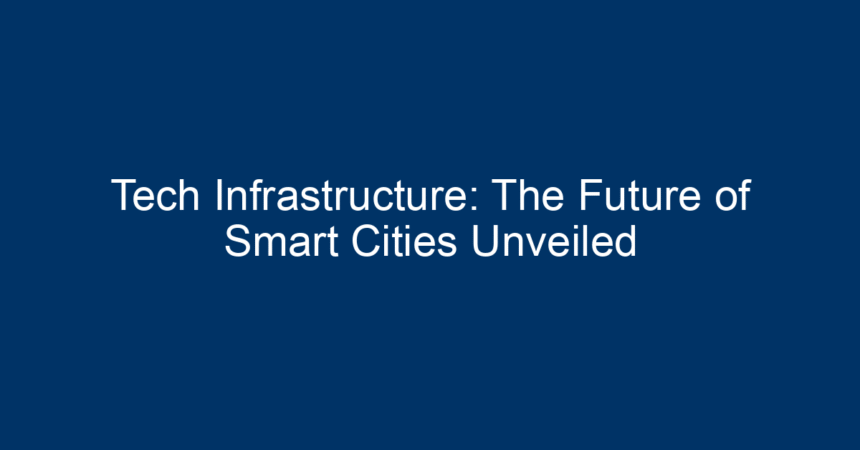In the digital age, urban landscapes are evolving rapidly, thanks to the integration of advanced technology into city planning and management. The concept of “smart cities” is reshaping how we think about urban living, emphasizing efficiency, sustainability, and enhanced quality of life for residents. At the heart of this transformation lies robust tech infrastructure, which serves as the backbone of smart city initiatives. This article will explore the key components of tech infrastructure, how it propels smart cities into the future, and its implications for citizens and governments alike.
Understanding Tech Infrastructure
What is Tech Infrastructure?
Tech infrastructure refers to the underlying frameworks—both hardware and software—that support the deployment and operation of digital technology within a city. This includes high-speed internet, data centers, IoT devices, cloud computing, and other technologies required to facilitate intelligent urban services. In essence, a strong tech infrastructure is crucial for the seamless integration of technology into everyday city life.
Importance of Tech Infrastructure
Tech infrastructure forms the foundation of all smart city initiatives. Without it, efforts to create a connected urban landscape would falter. This infrastructure enables various applications, such as smart transportation systems, energy-efficient buildings, and waste management solutions—each of which contributes to the overall functionality and sustainability of a city.
Key Components of Tech Infrastructure
1. High-Speed Internet Connectivity
Reliable and robust internet connectivity is the bedrock of any smart city. High-speed broadband access ensures that services are accessible to all citizens and facilitates the operation of smart technologies. Cities are investing in:
- Fiber Optic Networks: The backbone for high-speed internet that offers quicker data transmission.
- 5G Networks: The next generation of wireless technology, enabling real-time data exchange and low-latency communication.
2. IoT Devices and Sensors
The Internet of Things (IoT) plays a crucial role in collecting data that enhances city functions. Sensors and devices communicate with each other in real-time, leading to smarter decision-making. Common applications include:
- Traffic Management Systems: Sensors monitor traffic patterns and adjust signals to reduce congestion.
- Smart Waste Management: Sensors in bins signal when they are full, optimizing waste collection routes.
3. Data Analytics Platforms
Data is at the heart of smart city operations. Advanced analytics platforms process and analyze enormous volumes of data collected from various sources. This analysis leads to actionable insights, allowing city planners and administrators to make informed decisions. Key benefits include:
- Predictive Maintenance: Anticipating when infrastructure needs repairs.
- Resource Allocation: Directing resources where they are needed most.
4. Cloud Computing and Storage
The cloud is vital for managing the vast amounts of data generated in a smart city. Cloud computing provides:
- Scalability: Cities can adjust their storage capacity and computing power based on their evolving needs.
- Cost Efficiency: Reduces the need for expensive on-premises infrastructure.
Real-World Applications of Tech Infrastructure in Smart Cities
Smart Transportation
Tech infrastructure plays a transformative role in transportation systems. For example, cities are implementing:
- Connected Vehicles: These vehicles communicate with each other and the surroundings, improving safety and efficiency.
- Public Transport Apps: Real-time tracking and updates through mobile applications enhance the commuting experience.
Sustainable Energy Management
Smart cities aim to reduce energy consumption and promote sustainability. Tech infrastructure enables:
- Smart Grids: These grids optimize electricity distribution and allow consumers to monitor their usage.
- Renewable Energy Sources: Integration of solar panels and wind turbines into the city’s energy mix, controlled by advanced management systems.
Enhanced Public Safety
Safety is a priority for any urban environment. Robust tech infrastructure facilitates:
- Surveillance Systems: Smart cameras equipped with AI can detect suspicious activities and alert law enforcement.
- Emergency Response Systems: Faster communication between citizens and emergency services through apps and platforms.
The Challenges Facing Tech Infrastructure Development
Despite the many advantages, developing tech infrastructure in smart cities is not without challenges:
1. Funding and Investment
Building a solid tech infrastructure requires significant capital investment. Many local governments face budget constraints that limit their ability to fund these projects.
2. Data Privacy Concerns
With the collection and analysis of vast amounts of data comes the risk of privacy breaches. Cities must establish robust data governance frameworks to protect citizen information.
3. Technological Inequality
Not all residents have equal access to technology. Bridging the digital divide is essential to ensure that all citizens benefit from smart city initiatives.
The Future of Tech Infrastructure in Smart Cities
Emerging Trends
The future of tech infrastructure in smart cities will be shaped by several emerging trends:
- AI Integration: Artificial Intelligence will play a crucial role in decision-making processes, enhancing efficiency.
- Blockchain: This technology may provide secure and transparent transactions related to city services.
- Green Technologies: Eco-friendly tech infrastructure will become vital as cities aim for carbon neutrality.
Collaborative Approaches
The development of tech infrastructure for smart cities will increasingly rely on public-private partnerships. Collaboration between government agencies and tech companies can drive innovation and provide the necessary resources for implementing large-scale projects.
Conclusion: Embracing the Future of Smart Cities
As urbanization continues to accelerate, the importance of robust tech infrastructure in fostering smart cities cannot be overstated. From enhanced transportation to improved public safety and sustainable energy management, the benefits of smart cities ripple through the fabric of society, improving the quality of life for residents.
Local governments, businesses, and citizens must work collaboratively to overcome the challenges associated with developing this infrastructure. By investing in reliable technology, addressing data privacy concerns, and ensuring equitable access to resources, we can fully realize the potential of smart cities.
Actionable Insights:
-
Get Involved: Citizens should engage with local government initiatives focusing on tech infrastructure to voice their needs and concerns.
-
Stay Informed: Keep abreast of local smart city projects and how they impact daily life. Knowledge empowers citizens to participate actively.
- Advocate for Sustainability: Encourage local officials to invest in green technologies as part of tech infrastructure development.
In the end, the fusion of tech infrastructure and urban living is not just about convenience; it is about creating a sustainable, efficient, and inclusive future for all. Harnessing the potential of smart cities means investing in a better tomorrow, today.




